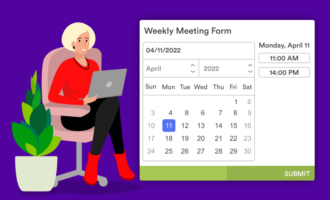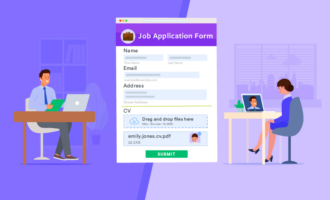As employers look to improve workplace culture, and find and retain top talent, many are considering implementing employee wellness programs. Why?
In the short term, targeted wellness programs focusing on disease management for employees with chronic illnesses have an ROI of more than three times an employers’ investment. Wellness programs promote healthy lifestyles that result in happier, more productive employees, and potentially lower health insurance premiums for employers.
HR professionals can follow the six steps below to create an employee wellness program that has high engagement and makes a lasting impact on the well-being of their entire team.
How to create an employee wellness program
- Identify which wellness programs your employees need
- Establish goals for your wellness program
- Design the program
- Incentivize or reward participants
- Communicate the details of your wellness program
- Evaluate your wellness program
Identify which wellness programs your employees need
Establish goals for your wellness program
Design the program
- Start simply. Gabby Shultis, head of client success at Nectafy, credits simplicity as key to program success. “If the program is too complex or time-consuming, you’ll lose people right from the beginning,” she says. “Make the program both appealing and attainable, and you’ll have more buy-in.”
- Be creative. There is no “standard” wellness program. Tailor your program to fit the needs and goals of your team.
- Consider your budget. Can you offer health trackers, provide access to a fitness center or gym, or reimburse for health equipment purchases? Don’t overpromise.
- Follow regulations. Keep in mind federal, state, or local regulations and any liability concerns when designing your program. The relevant laws to consider include the ADA, GINA, HIPAA, and the Patient Protection and Affordable Care Act.
Incentivize or reward participants
Communicate the details of your wellness program
- Including information about your wellness program in your policy handbook
- Providing the tools necessary to get started, like gym access and water bottles, and resources to measure progress, such as Fitbits or step counters
- Marketing consistently to encourage steady employee participation
- Maintaining a leaderboard if the wellness program includes competitions
- Announcing winners, prizes, and new contests in multiple mediums, like company newsletters, emails, etc.
Evaluate your wellness program
- What aspects of the wellness program are they using?
- What changes have they made because of the wellness program?
- What isn’t important to them about the program?
- What do they think is missing?
Wellness programs include everything from weight loss and smoking cessation programs to fitness challenges and stress management seminars. With so many options available, it’s important to begin by surveying your employees about their wellness goals. What you learn will help you to choose relevant programs.
Ask your health insurance plan administrator early in your planning process about any wellness programs they offer to encourage employee engagement.
Constructing an employee wellness program survey is easy with secure Jotform questionnaire templates. You can customize a template with your specific questions and to match your organization’s branding.
Before you create any plans, identify what you’re trying to achieve. According to the Society for Human Resource Management (SHRM), your goals should be tied to objectives that are “clear, time-limited, and stated in such a way that it is easy to determine whether they have been achieved.”
For example, your objectives may be “to have a 90 percent participation rate in fitness challenges” or “to reduce the number of employees who smoke by 25 percent in fiscal year 20XX.” Once you’ve analyzed the data and set goals for your wellness program, you can begin to build it.
After surveying your employees and setting program goals based on their responses, it’s time to design your wellness program. Here are some tips:
Especially in these volatile times, it’s important to consider how to make your wellness program available for your team in an entirely remote fashion, if necessary.
“Working remotely can be challenging. Employees are often isolated, and it can be difficult to turn work ‘off’ at the end of the day since you don’t leave an office,” Shultis says. “Wellness programs allow remote companies to come together in fun ways even when employees are scattered all across the world, and it encourages everyone to step away from the computer from time to time and get moving more throughout the day.”
Once you’ve created your program, decide how to award or incentivize participants. Rewards are a great motivator, if you choose the right ones.
Gift cards or certificates, prizes related to themed challenges (such as pies during a Thanksgiving fitness challenge), athletic gear, or even a “winner’s choice” gift up to a certain amount have all been popular prizes for the remote team at Nectafy, according to Shultis. Just keep in mind any federal or state compliance regulations regarding what your company can or cannot offer.
Use different communication methods and channels to help you get your wellness program rolling. Keep employees continuously in the loop as the program takes root. When you introduce the program to your employees, be prepared to tell them what the program does, who it’s for, how to participate, and how long it lasts.
Consider doing the following:
Revisit your wellness program during team meetings to gauge interest and see who is participating. This is your opportunity to check in and encourage participation.
Continuously evaluate the success of your wellness program to determine if it meets your goals or if it needs to be changed. According to Shultis, the best way to evaluate your program is to monitor participation.
“The higher [the participation], the more effective your program. If participation starts to slip, then you know people aren’t interested and engaged in what you’re offering, and you need to rethink your approach,” she says.
“Are you asking too much of employees? Or too little, so that it’s not exciting or challenging enough? Are you offering prizes, and if so, are they prizes that employees want or care about? These are all questions to ask yourself if you see declining participation levels.”
Evaluation forms available from Jotform make it easy to check in with employees and receive honest feedback about your company wellness program. Shultis recommends asking the following questions:
Shultis adds that asking remote workers for feedback and suggestions for your company wellness program will make them feel like they are part of a team and make them more likely to participate.












































































































Send Comment: